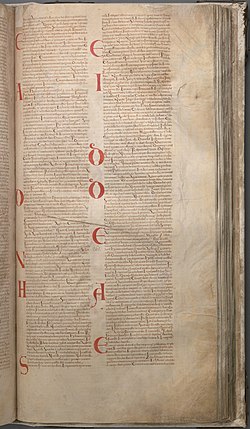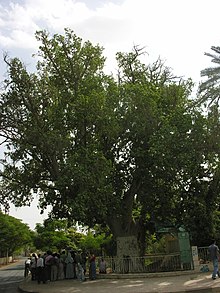Luke 19
| Luke 19 | |
|---|---|
 The inscription of Luke 19:46 in Latin on the architrave at the portal of the church of Santa Trinità in Trento, Italy. | |
| Book | Gospel of Luke |
| Category | Gospel |
| Christian Bible part | New Testament |
| Order in the Christian part | 3 |
Luke 19 is the nineteenth chapter of the Gospel of Luke in the New Testament of the Christian Bible. It records Jesus' arrival in Jericho and his meeting with Zacchaeus, a parable and his arrival in Jerusalem.[1] The book containing this chapter is anonymous, but early Christian tradition uniformly affirmed that Luke composed this Gospel as well as the Acts of the Apostles.[2]
Text[]

The original text was written in Koine Greek. This chapter is divided into 48 verses.
Textual witnesses[]
Some early manuscripts containing the text of this chapter are:
- Papyrus 75 (AD 175-225)
- Codex Vaticanus (325-350)
- Codex Sinaiticus (330-360)
- Codex Bezae (~400)
- Codex Washingtonianus (~400)
- Codex Alexandrinus (400-440)
- Codex Ephraemi Rescriptus (~450; extant verses 42-48)
Old Testament references[]
- Luke 19:38: Psalm 118:26[3]
- Luke 19:46: Isaiah 56:7; Jeremiah 7:11
Jesus comes to Zacchaeus’ house[]


Zacchaeus (Greek: Ζακχαῖος, Zakchaios; Hebrew: זכי, "pure", "innocent" [4]) of Jericho was wealthy, a chief tax collector, mentioned only in the Gospel of Luke.[5] A descendant of Abraham, he was a poster child for Jesus' personal, earthly mission to bring salvation to the lost.[6] Tax collectors were despised as traitors (working for the Roman Empire, not for their Jewish community), and as being corrupt.
Parable of the minas[]
- Now as they heard these things, He spoke another parable, because He was near Jerusalem and because they thought the kingdom of God would appear immediately.[7]
The journey which Jesus had embarked on "steadfastly" in Luke 9:51 is drawing towards its climax. Hugo Grotius held that "they" (who heard these things) refers to the disciples. Heinrich Meyer argues that "they" were the murmurers of verse 7.[8]
Jesus' entry to Jerusalem[]
As he drew near to the city, Jesus wept, anticipating the destruction of the Temple.[9] Lutheran biblical scholar Johann Bengel contrasts Jesus' reaction with the immediately preceding scene of rejoicing:
- Behold before thee the compassionate King, amidst the very shouts of joy raised by His disciples!
- Jesus weeps over Jerusalem, and yet compels no man by force.[10]
See also how Jesus wept at the death of his friend Lazarus (John 11:35).
Jesus in the Temple[]
Verse 46[]
- [Jesus] Saying unto them, It is written, My house is the house of prayer: but ye have made it a den of thieves.[11]
In expelling the dealers from the Temple, Jesus' words draw from both Isaiah 56:7 (a house of prayer for all nations) and Jeremiah 7:11 (a den of thieves). Matthew 21:13[12] and Mark 11:17 have the same quotations.
Verse 47[]
- And He was teaching daily in the temple. But the chief priests, the scribes, and the leaders of the people sought to destroy Him.[13]
Luke reiterates at Luke 21:37 and 23:27 that Jesus taught in the Temple on a daily basis.
Verse 48[]
- and [they] were unable to do anything; for all the people were very attentive to hear Him.[14]
Literally, the people “were hanging from him”, i.e. hung on His lips.[15] The Jerusalem Bible translates as "the people as a whole hung on his words".[16]
See also[]
- Jericho
- Mina
- Ministry of Jesus
- Parables of Jesus
- Sycamore tree
- Zacchaeus
- Related Bible parts: Isaiah 56, Jeremiah 7, Zechariah 9, Matthew 21, Matthew 25, Mark 11, John 2, John 12
References[]
- ^ Halley, Henry H. Halley's Bible Handbook: an Abbreviated Bible Commentary. 23rd edition. Zondervan Publishing House. 1962.
- ^ Holman Illustrated Bible Handbook. Holman Bible Publishers, Nashville, Tennessee. 2012.
- ^ Kirkpatrick, A. F. (1901). The Book of Psalms: with Introduction and Notes. The Cambridge Bible for Schools and Colleges. Book IV and V: Psalms XC-CL. Cambridge: At the University Press. p. 840. Retrieved February 28, 2019.
- ^ Milligan, Jim. "Lexicon :: Strong's G2195 - Zakchaios". Blue Letter Bible. Sowing Circle.
- ^ Luke 19:1–10
- ^ Warfield, Benjamin Breckinridge. "Jesus' Mission, According to His Own Testimony". Monergism. CPR Foundation.
- ^ Luke 19:11 NKJV
- ^ Meyer, H. A. W., Meyer's NT Commentary on Luke 19, accessed 9 August 2020
- ^ Luke 19:41–44
- ^ Bengel, J. A., Bengel's Gnomon of the New Testament on Luke 19, accessed 11 July 2018
- ^ Luke 19:46: KJV
- ^ Huey, F. B. (1993). The New American Commentary - Jeremiah, Lamentations: An Exegetical and Theological Exposition of Holy Scripture, NIV Text. B&H Publishing Group. p. 106. ISBN 9780805401165.
- ^ Luke 19:47: NKJV
- ^ Luke 19:48: NKJV
- ^ Farrar, F. W. (1891), Cambridge Bible for Schools and Colleges on Luke 19, accessed 12 August 2020
- ^ Jerusalem Bible (1966), Luke 19:48
External links[]
- Luke 19 King James Bible - Wikisource
- English Translation with Parallel Latin Vulgate
- Online Bible at GospelHall.org (ESV, KJV, Darby, American Standard Version, Bible in Basic English)
- Multiple bible versions at Bible Gateway (NKJV, NIV, NRSV etc.)
| Preceded by Luke 18 |
Chapters of the Bible Gospel of Luke |
Succeeded by Luke 20 |
- Gospel of Luke chapters